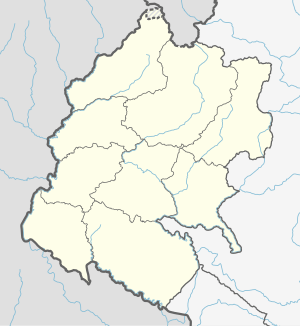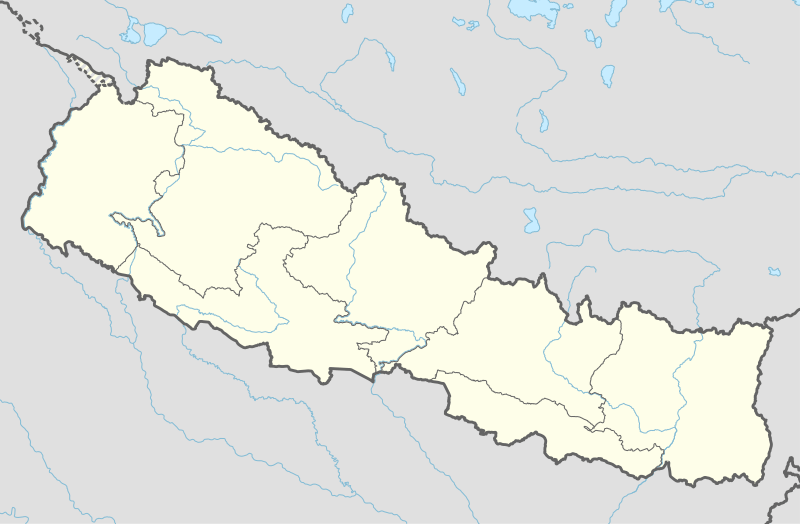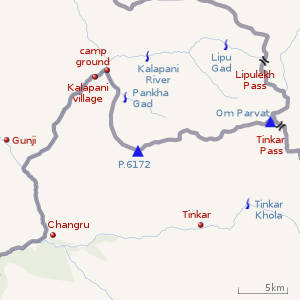Tinkar
Tinkar is a village in the Byas municipality of Darchula District in the Sudurpashchim province of Nepal. It is named after Tinkar Khola river, a tributary of the Mahakali River, which it joins near the village of Chhangru. At the top of the Tinkar valley near the Tibet border is the Tinkar Pass (5,258 m), which has traditionally provided the trading route for the Byansis of the region for the Tibetan trading centre Burang.[3][4][5]
Tinkar | |
|---|---|
village | |
 Tinkar Location in Sudurpashchim Pradesh  Tinkar Tinkar (Nepal) | |
| Coordinates: 30.1355°N 80.9848°E | |
| Province | Sudurpashchim |
| District | Darchula |
| Rural Municipality | Byas |
| Highest elevation | 5,258 m (17,251 ft) |
| Lowest elevation | 3,650 m (11,980 ft) |
| Time zone | UTC+5:45 |
Geography
 |
Tinkar is in the far-western region of Nepal, in the province of Sudurpashchim Pradesh at the high end of the Great Himalayan range, elevation 3,650 metres (11,980 ft). It is the principal village in the valley of the Tinkar River (Tinkar Khola), which is a tributary of the Mahakali River (or Kali River and Sarda River). Mahakali serves as the western boundary of Nepal with India, beyond which lies the Indian region of Kumaon (part of the Uttarakhand state).
Along the Tinkar Valley, closer to the border, is another large village called Chhangru (or Changru). Tinkar (80 households) and Chhangru (100 households) are populated by Byansi people, who speak a West Himalayish language called Byangsi. The region across the border in Kumaon is also populated by Byansi people, with whom the Byansis of the Tinkar Valley have cultural and historical links. A third village called Ghaga, at the confluence of Tinkar and Nampa rivers, is populated by other classes of people.[6]
Upstream along one of the headwaters of the Tinkar Khola is the Tinkar Pass (or "Tinkar Lipu"[7]) at the top of the Great Himalayan range, which provides a historical trading route for the Byansis to the Tibetan town of Burang. This pass is however insignificant for the overall economy of Nepal because the far-western region is cut off from the rest of the country by "high impassable mountains and glaciers".[8] Manzard et al. state that the Tinkar Byansis also used to use the Lipulekh Pass because the Tinkar Pass is quite difficult to traverse.[6]
While the general border runs along the Mahakali River, in the upper headwaters above the Kalapani village, it is the watershed of the streams that flow into the river. This was a decision made by the British Indian government in the 19th century.[9][10] Two significant peaks, Mount Api (6180 m) and Om Parvat (5590 m), lie on this watershed range, which are popular trekking destinations.[3][5] Nepal has ongoing claims to the territory beyond the watershed, up to the main headwater stream, which is termed the Kalapani territory.[11][12]
History
According to the Himalayan Gazetteer, the entire Byans region to the south as well as north of the Mahakali River used to be part of Kumaon.[13] After the unification of Nepal in the 18th century, Nepal expanded northwest and conquered the kingdoms of Kumaon as well as Garhwal. The expansion lasted till 1815. In that year, during the Anglo-Nepalese War, the British general Ochterlony evicted the Nepalese from Garhwal and Kumaon across the Mahakali River.[14][15] After agreeing the Treaty of Sugauli, which made a territorial settlement, the Nepalese appealed to the British governor general that they were entitled to the areas to the southeast of the Mahakali River. The British conceded the demand, and the Tinkar Valley with its large villages of Chhangru and Tinkar was transferred to Nepal. The British, however, retained the areas to the northwest of the Mahakali River, including the Kuthi Valley and the Kalapani territory near the headwaters of the Mahakali.[13][16]
The Tinkar Pass at the top of the Tinkar Valley is the de facto tri-junction between China, India and Nepal. The Article 1 of the China–Nepal border treaty of 1961 states:
The Chinese-Nepalese boundary line starts from the point where the watershed between the Kali River and the Tinkar River meet the watershed between the tributaries of the Mapchu (Karnali) River on the one hand and the Tinkar River on the other hand.[17]
This being the precise geographical description of the location of the Tinkar Pass, the Border Pillar numbered 1 of the China–Nepal border was placed here.[18]
Following the Chinese take-over of Tibet, India and Nepal jointly operated a number of checkposts along the Tibet border starting in 1952.[19] According to Nepalese geographer Buddhi Narayan Shrestha, one of these was at the Tinkar Pass.[20][lower-alpha 1] In 1969, Nepal asked for the Indian personnel at these posts to be withdrawn, and India did so. Former Indian Army general Ashok K. Mehta states that none of the posts remained afterwards.[12] Subsequently, India stepped up security and surveillance on the Indian side of the Nepal–India border and also introduced a permit system for the use of Indian roads.[21]
According to The Rising Nepal, a checkpost was established at the Tinkar village around 1972, by an Assistant Sub-Inspector, who was also in charge of patrolling up to Chhangru. The officer claimed to have patrolled up to the Kalapani village with arms once, along the Indian road, while the Indian security kept him under surveillance. He was denied a permit to visit it a second time.[21]
After the 1962 border war between India and China, India closed the Lipulekh Pass at the top of the Kalapani river valley. The Byansis of Kumaon then used the Tinkar Pass for all their trade with Tibet.[22][23] In 1997, India and China agreed to reopen the Lipulekh pass,[24] and the use of the Tinkar Pass had declined.
Status
According to the Chairperson of the Byas Rural Municipality, Chhangru is the last Nepali village along the Mahakali river heading north.[lower-alpha 2] He states that the roads on the Nepali side are bad and the villagers have to use the Indian roads to get to Chhangru.[lower-alpha 3] They have to obtain permits from the Indian administration for this purpose. He complained of the attitude of the Indian administrators, which he described as "condescending".[26]
There is a walk bridge over the Mahakali River near Chhangru called Sita Pul, which allows passage between India and Nepal. Nepal used to have a customs point at this location, which was abandoned during the conflict period, and has not yet been reinstated.[27] During the conflict period, the area was controlled by the Maoist rebels, who charged "tax" (protection money) on wildlife trafficking through the Tinkar route. Illegal animal products from India are said to have been trafficked, including tiger skins, tiger bones and parts, musk deer pouches and yarsagumba. The Nepali Times journalists estimated that the rebels earned Rs. 35 million annually through such "taxes".[25] Such trafficking is still ongoing as of 2019.[28]
News reports in May 2018 state that the trade with Tibet is "almost nil", and it has been so for the last five or six years. "There is neither road access from the Nepal side to bring goods imported from Tibet nor is there [a] customs office," according to The Kathmandu Post.[27]
Between 2013 and 2020, India laid a (motorable) link road on the Indian side of the river. When it was inaugurated in May 2020, the Nepalese government protested, calling it a "unilateral act".[29]
Bir Bahadur Chand, the police officer that established the Tinkar checkpost, states that the controversies surrounding the Kalapani territory are raised only by the Kathmandu media, and they cause a lot of difficulties for the people of the Tinkar region.[21]
See also
- Lipulekh pass
Notes
- Shrestha calls them "Indian posts", but they were in fact Nepalese posts set up with Indian assistance, and had only technical personnel from India. See Sen, N. C. (1969), "Changing Indo-Nepal Relations", China Report, 5 (5): 20–22, doi:10.1177/000944556900500505
- It is to the south of Gunji where the Kuthi Yankti and Kalapani rivers merge, which India officially regards as the starting point of the Kali river. Even though the Chairperson says that Changru is the last village "not under India's control", that assertion is contracted by the Nepali Times journalists, who reported going up to 600 metres near the Kalapani stream before being stopped by the Indian security.[25]
- Even earlier, Manzardo et al. noted that the Byansis used the road on the Indian side because it was easier to traverse.[6]
References
- Śreshṭha, Border Management of Nepal (2003), p. 243
- Tinker transit point unguarded, The Himalayan Times, 19 January 2019.
- "Valleys of Nepal‛s Northwestern Corner". www.ai.stanford.edu. April 2016. Retrieved 20 November 2019.
- "Tinkar Pass". Retrieved 20 November 2019.
- "Api Best Camp, West Nepal" (PDF). Mountain Kingdoms Ltd. Retrieved 28 November 2019.
- Manzardo, Dahal & Rai, The Byanshi (1976), p. 85.
- Heim & Gansser, The Throne of the Gods (1939), p. 207.
- Schrader, Trading Patterns in the Nepal Himalayas (1988), p. 99.
- Manandhar & Koirala, Nepal-India Boundary Issue (2001), pp. 3–4: "The map 'District Almora' published by the Survey of India [during 1865–1869] for the first time shifted the boundary further east beyond even the Lipu Khola (Map-5). The new boundary moving away from Lipu Khola follows the southern divide of Pankhagadh Khola and then moves north along the ridge."
- Atkinson, Himalayan Gazetteer, Vol. 3, Part 2 (1981), pp. 381–382 and Walton, Almora District Gazetteer (1911), p. 253: "The drainage area of the Kalapani lies wholly within British territory, but a short way below the springs the Kali forms the boundary with Nepal." (Emphasis added)
- It's ours, The Economist, 2 July 1998.
- Ashok K. Mehta, Delhi Can’t Anger Nepal Too — Kalapani Issue Must Be Resolved ASAP, The Quint, 17 December 2019.
- Atkinson, Himalayan Gazetteer, Vol. 2, Part 2 (1981), pp. 679–680.
- Whelpton, A History of Nepal (2005), p. 41-42.
- Rose, Nepal – Strategy for Survival (1971), pp. 83–85: "Ochterlony forced Amar Singh Thapa to agree at Malaun to terms under which the Nepali army retired with their arms, and the territory between the Kali and Sutlej rivers came under the control of the British."
- Manandhar & Koirala, Nepal-India Boundary Issue (2001), p. 4.
- Cowan (2015), p. 16.
- Cowan (2015), pp. 16–17.
- Kavic, India's Quest for Security (1967), p. 55: "The extent of these precautionary measures is reflected in the rise in the cost of these defence posts from $42,000 (1952) to $280,000 (1954)".... "[25] The initiative reportedly came from Nepal. See Robert Trumbull in the New York Times, 16 February 1950."
- Cowan (2015), p. 8.
- Gokarna Dayal, I Used To Patrol With Arms In Kalapani 48 Years Ago: Nepal Police ASI, The Rising Nepal, 12 May 2020.
- Schrader, Trading Patterns in the Nepal Himalayas (1988), p. 99: "Lipu La, however, was closed in 1962, due to the strained Sino-Indian relations. Today remaining trade moves via Tinkar La."
- Manzardo, Dahal & Rai, The Byanshi (1976), p. 85: "Previously there were two passes to Tibet, the Lipu pass (Lipu la) and the Tinkar pass (Tinkar la), but now only the Tinkar pass is accessible, since the Indians have closed Lipu pass to trans-Himalayan traffic."
- Rose, Leo E. (January–February 1999), "Nepal and Bhutan in 1998: Two Himalayan Kingdoms", Asian Survey, 39 (1): 155–162, JSTOR 2645605
- K. C. Sharad, Kalapani's new ‘line of control’, Nepali Times, 10 September 2004.
- Ram Chandra Bhandari, No border marks in Kalapani, locals at mercy of Indian administration, Lokantar, 10 November 2019.
- Nepal-Tibet trade hit for lack of road and other facilities, The Kathmandu Post, 20 October 2018.
- Sonia Awale, Nepal-China Connectivity Aid Wildlife Smuggling, The Pangolin Reports, 6 September 2019. "New trans-Himalayan roads have also made it easier for wildlife smugglers transporting contraband from India to China via Nepal. Besides Rasuwagadi, Olangchungola in Taplejung, Kimathanka in Sankhuwasaba, Ilam in eastern Nepal, Tinkar Pass in Darchula and Hilsa in Humla are new smuggling routes."
- PTI, Nepal objects to India's ‘unilateral’ opening of link road to Kailash Manasarovar, The Print, 9 May 2020.
Bibliography
- Atkinson, Edwin Thomas (1981) [first published 1884], The Himalayan Gazetteer, Volume 2, Part 2, Cosmo Publications – via archive.org
- Atkinson, Edwin Thomas (1981) [first published 1884], The Himalayan Gazetteer, Volume 3, Part 2, Cosmo Publications – via archive.org
- Cowan, Sam (2015), The Indian checkposts, Lipu Lekh, and Kalapani, School of Oriental and African Studies
- Heim, Arnold; Gansser, August (1939), The Throne of the Gods: An account of the first Swiss expedition to the Himalayas (PDF), Macmillan
- Manandhar, Mangal Siddhi; Koirala, Hriday Lal (June 2001), "Nepal-India Boundary Issue: River Kali as International Boundary", Tribhuvan University Journal, 23 (1)
- Manzardo, Andrew E.; Dahal, Dilli Ram; Rai, Navin Kumar (1976), "The Byanshi: An ethnographic note on a trading group in far western Nepal" (PDF), INAS Journal, Institute of Nepal and Asian Studies, Tribhuvan University: 84–118
- Rose, Leo E. (1971), Nepal – Strategy for Survival, University of California Press, ISBN 978-0-520-01643-9
- Schrader, Heiko (1988), Trading Patterns in the Nepal Himalayas, Bow Historical Books, ISBN 978-3-88156-405-2
- Walton, H. G., ed. (1911), Almora: A Gazetteer, District Gazetteers of the United Provinces of Agra and Oudh, 35, Government Press, United Provinces – via archive.org
- Whelpton, John (2005), A History of Nepal, Cambridge University Press, ISBN 978-0-521-80470-7